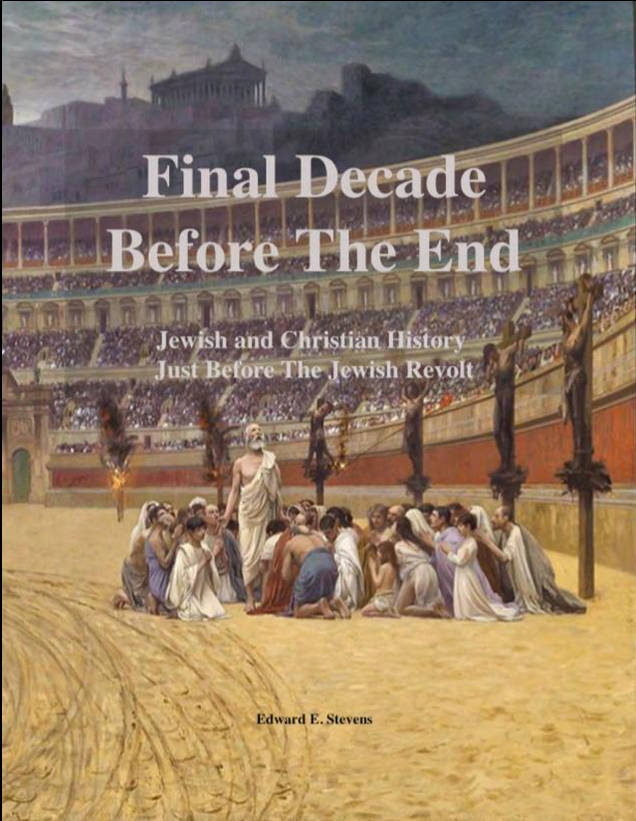Edward E. Stevens, Final Decade Before the End: Jewish and Christian History Just Before the Jewish Revolt (Bradford, PA: International Preterist Association, 2014).
Edward Stevens is one of the most vocal modern proponents of full preterism, the belief “that Christ has already fulfilled his promise to return and consummate redemption in himself and his ongoing spiritual kingdom (the church).”1 Per Stevens, the “battle of Armageddon was fought at AD 70 when God used the Roman armies to stop the Jewish persecution of Christians.”2 Further, by the conclusion of the war, “all the Old Testament prophecies about the Kingdom and Jesus’ return had been fulfilled.”3
I don’t accept these preterist beliefs. Rather, I anticipate a pretribulational premillennial return of Christ, at which time Christ will establish his millennial kingdom, fulfilling his promises to national Israel. Although, my alignment of the rapture and tribulation in the narrative of Revelation is a bit unorthodox, as elaborated in my article in Eleutheria (now called the Liberty Theological Review).4
Regardless, what I do appreciate is that Stevens’ Final Decade Before the End argues for an early Matthew and Mark. More broadly, the book develops a timeline for key events between Christ’s death (which Stevens places in AD 30) and the Jewish rebellion in AD 66, with particular focus on the travels of Paul and the authoring of the NT writings. Biblical and historical data is cited throughout to support his timeline. Few modern scholars are willing to commit themselves to the level of detail which Stevens offers, yet even if we were to challenge particular dates, I contend that there is still value to the exercise. For example, with respect to Galatians, Stevens argues that the letter was written after the Jerusalem Council, during Paul’s second missionary journey, while Paul was in Corinth.5 Whereas, I contend that Galatians was written around two years earlier, before the Jerusalem council (which Stevens dates as AD 49).
Stevens dates Matthew as being published in AD 31–38 and Mark as AD 38–44.6 Again, this is on the premise that the resurrection was in AD 30. Stevens notes the parallels between Matthew 24 (the Olivet Discourse) and Paul’s letters to the Thessalonians as a basis for arguing that Matthew was written before AD 51, his date for the Thessalonian letters, with the assumption that he could have acquired a copy when he was in Jerusalem for the council.7 However, his basis for then pushing the date of Matthew into the 30s is due to a consideration of the intended audience.
Matthew’s gospel was clearly written with a Hebrew Jewish audience in mind, while Mark’s gospel was written from more of a Hellenistic perspective. Matthew writes as if he is not aware of any uncircumcised Gentile believers, nor writing with their perspective in mind. He does not explain things for the Gentiles, like Mark and Luke did. Everything he says is coming from a Jewish perspective, and written to Jewish people who did not need an explanation for all those things. This implies that Matthew wrote at a time before the uncircumcised Gentiles (e.g., Cornelius) had been brought into the Church, when the Church was still totally Jewish (i.e., before AD 38).8
With regard to Mark, Stevens contends:
Since it seems that Mark was still in Jerusalem consulting with Peter at the time he wrote his gospel [per the testimony of Eusebius and others], and apparently had access to Matthew’s gospel [given the textual similarities], I would prefer to keep the date for Mark somewhere within the range of AD 41-44. That is after the latest likely date for Matthew (AD 38), and before Mark went to Antioch with Barnabas and Paul in AD 44. It also was after the first Gentiles had come into the Church (AD 38) and after the Caligula crisis (AD 39-41).9
These arguments line up well with what I have advocated; although, I’ve allowed a bit more flexibility on dates, given the uncertainty of the date of Christ’s resurrection.
- Edward E. Stevens, What Happened in A.D. 70? (Bradford, PA: International Preterist Association, 2018), 7. ↩︎
- Ibid., 10. ↩︎
- Ibid. ↩︎
- “A Chronologically Oriented Reassessment of the Apocalypse Interludes: The Great Multitude Pretribulational Rapture,” Eleutheria 8, no. 1 (Spring 2024). https://digitalcommons.liberty.edu/eleu/vol8/iss1/3. ↩︎
- Edward E. Stevens, Final Decade Before the End: Jewish and Christian History Just Before the Jewish Revolt (Bradford, PA: International Preterist Association, 2014), 29–30. ↩︎
- Ibid., 14. ↩︎
- Ibid., 14–15. ↩︎
- Ibid., 18–19. ↩︎
- Ibid., 20–21. ↩︎
NOTE: Comments and dialog are welcome. The “Leave a Reply” field will be accessible below for 10 days after this post was published. Afterwards, please feel free to continue to comment via the contact page. (This is my attempt to manage the spam bots.)





